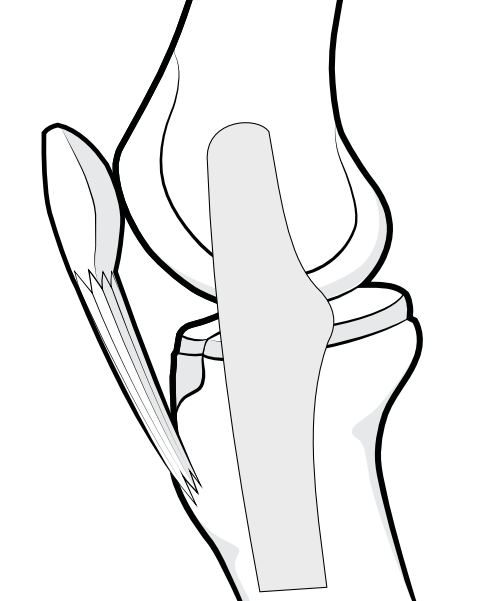The medial collateral ligament (MCL) is a band of fibrous tissue supporting the medial (inner) aspect of the knee joint.
 Page updated May 2024 by Dr Sheila Strover (Clinical Editor)
Page updated May 2024 by Dr Sheila Strover (Clinical Editor)

View of the side of the knee, showing the extent of the superficial part of the MCL.
View from the front of the knee.
Anatomy of the Medial Collateral Ligament (MCL)
The medial collateral ligament is a band of fibrous tissue supporting the medial (inner) aspect of the knee joint.
The medial and lateral collateral ligaments form part of the capsular structures of the knee and are not visible from within the knee cavity in the same way that the cruciate ligaments are.
The MCL has both a superficial and a deep component, which are separated by a 'pocket' called a bursa. The superficial component has a connection to the posterior (rear) part of the outer rim of the medial meniscus, while the deep component is even more intimately associated with the central part.
-
Quote from peer-reviewed paper:
"...The medial collateral ligament (MCL) is a major stabilizer of the knee joint, providing support against rotatory and valgus forces....[it] is the most common knee ligament to be injured during knee trauma...."
Citation: Vosoughi F, Rezaei Dogahe R, Nuri A, Ayati Firoozabadi M, Mortazavi J. Medial Collateral Ligament Injury of the Knee: A Review on Current Concept and Management. Arch Bone Jt Surg. 2021 May;9(3):255-262. doi: 10.22038/abjs.2021.48458.2401. PMID: 34239952; PMCID: PMC8221433.
How does the MCL get injured?
The MCL is commonly injured in sports, when the athlete plants a foot while running but then suddenly changes direction.
-
Quote from peer-reviewed paper:
"...MCL injury often presents as an isolated injury; nonetheless, it may occur in combination with other ligament injuries, mostly anterior cruciate ligament injury...."
Citation: Vosoughi F, Rezaei Dogahe R, Nuri A, Ayati Firoozabadi M, Mortazavi J. Medial Collateral Ligament Injury of the Knee: A Review on Current Concept and Management. Arch Bone Jt Surg. 2021 May;9(3):255-262. doi: 10.22038/abjs.2021.48458.2401. PMID: 34239952; PMCID: PMC8221433.
How can you tell if the MCL is torn or just sprained?
It is not always easy to tell. Both may be associated with an injury, with local pain and bruising.
A ruptured MCL may produce a loud 'pop!' at the time of the incident. The knee may also feel unstable and that it cannot be trusted.
The common test for MCL inadequacy is the varus stress test. The Slocum test may identify an MCL tear that may be present in addition to an ACL tear.
-
Quote from peer-reviewed paper:
"...Acute isolated MCL injury may present by local swelling, ecchymosis, and tenderness in the medial knee. Incomplete MCL injuries might be more painful than a complete tear of the MCL....During the physical examination, medial laxity of the knee in 30° flexion while abducted by a valgus force is indicative of MCL injury...."
Citation: Vosoughi F, Rezaei Dogahe R, Nuri A, Ayati Firoozabadi M, Mortazavi J. Medial Collateral Ligament Injury of the Knee: A Review on Current Concept and Management. Arch Bone Jt Surg. 2021 May;9(3):255-262. doi: 10.22038/abjs.2021.48458.2401. PMID: 34239952; PMCID: PMC8221433.
Can the collateral ligament heal without surgery?
Most MCL injuries will heal if the joint is properly protected during rehabilitation.
Usually bracing or a plaster of Paris is sufficient, but in severe cases surgical repair may be indicated.
Forum discussions
- Grade 2 MCL tear, one doctor says operate, second doctor say no need!?
Patients discuss the dilemma of whether or not a torn MCL needs surgical repair.
See also -
From the Experts -
- Journal interpretation - 2015 - Posteromedial Corner of the Knee: The Neglected Corner - interpreted by Dr Sheila Strover (Clinical Editor)